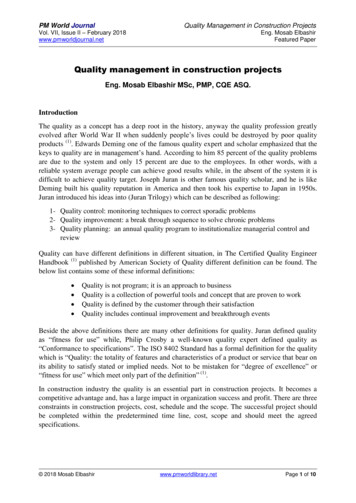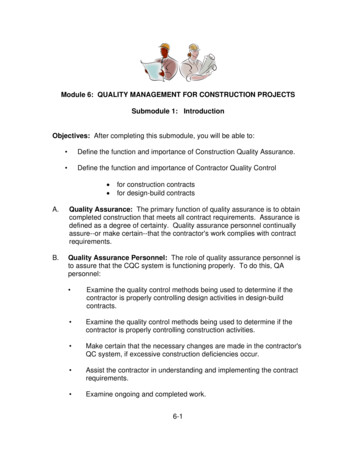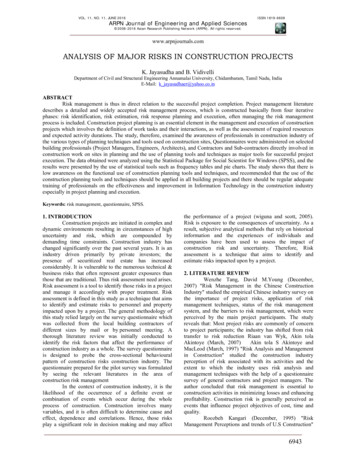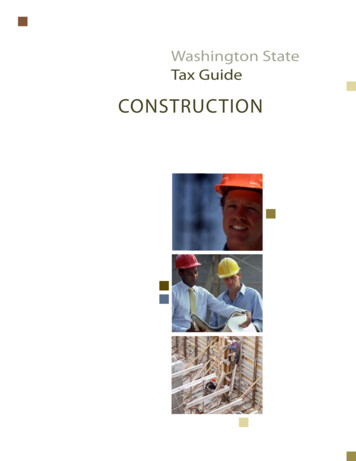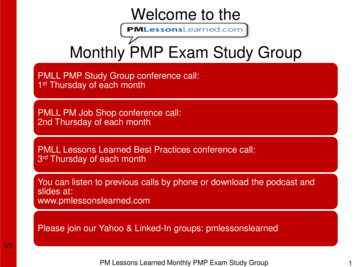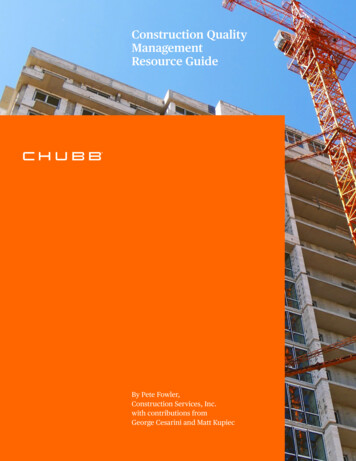
Transcription
Construction QualityManagementResource GuideBy Pete Fowler,Construction Services, Inc.with contributions fromGeorge Cesarini and Matt Kupiec
Chubb Construction Quality Management Resource GuideTableof ContentsIntroduction1. Why We Are Here32. The New World33. Common Construction Defects34. The Definition of Quality65. Managing Project Quality6Managing Construction Project Quality1. Introduction72. Definitions73. Project Definition84. Roles & Responsibilities85. The Project Quality Management Plan — Summary116. Before Construction127. During Construction168. After Construction17Quality-Focused Organizational Maturity21. Introduction172. Levels of Maturity183. Aspects of Maturity194. Maturity Audit21
Chubb Construction Quality Management Resource GuideIntroduction1. Why We Are HereThis guide is intended to serve people and organizations that work on buildingprojects and those who intend to improve the quality of the projects and theirorganizations. It outlines a quality management process for all players inthe building lifecycle: owners, developers, investors, insurers, designers, generalcontractors, material manufacturers, prime trade contractors (roofers, painters,electricians, etc.), subcontractors, and more.A high quality or mature organization is required to reliably deliver quality projects.Most people in the building business know that project problems often lead toclaims and litigation. Organizations like developers, insurers, and generalcontractors can attempt to influence or even mandate that trades and suppliersuse quality management systems on their projects. Regardless of where yourorganization is in this process, it will benefit from improving project quality andorganizational maturity.2. The New WorldConstruction professionals are living in a new world. Consumers expect qualityincreases and price decreases in all products, they are more conscious of buildingrelated health issues than ever before, they are more litigious, and there is aproliferation of attorneys.Hiring good, experienced people and expecting them to get it all right is no longerenough. The world of business generally, and building projects specifically, are fartoo complex. We need a system of checks and balances, to “inspect what we expect.”For anything resembling a guarantee of success we need to use defined processesto ensure defects don’t run downstream.3. Common Construction DefectsHistorically, builders and occupants were most concerned with structural stability,so soils and structural systems were the prime focus of the problems we faced.Over the last 30 years, we have seen fewer of these claims, and those we see areless catastrophic.More stringent energy requirements in the 1970s resulted in buildings becomingtighter and less fault tolerant. The most common defects have been related to buildingenclosures like roofs, walls, and waterproofing. High-risk failure points includingelements like showers and plumbing systems began to emerge. As building envelopescontinued to tighten, less fault-tolerant materials came into use, and the decline oftraining in the construction trades began to take effect. Now, as buildings havebecome more complex due to green building, “smart building” features, and otherdynamics, the plumbing, mechanical, and electrical systems are emerging as defectiveconditions more frequently.3
Chubb Construction Quality Management Resource GuideHigh-Risk Building Elements F oundations: Although building foundations are failing less frequently than ever, vigilance must be maintained in executingconstruction which conforms with the design requirements. And although “non-structural” concrete cracking rarely drives aproject into litigation, it’s often added to the list of complaints when it’s even slightly more pronounced than “normal.” S ub-grade Waterproofing: The tolerance for imperfection is low and moisture intrusion into basement level interiors, includingparking garages, is one of the most commonly litigated issues. E xterior Enclosure elements including stucco/plaster, masonry, and siding & trim: Large areas like exterior building walls arerarely defective, unless there is excessive stucco cracking, because these areas are simple and uniform. The devil is in the details.Exterior walls usually fail at interface conditions like roof to wall, fenestration openings, product transitions, or penetrations.See the “SAMPLE CHECKLIST FOR EXTERIOR BUILDING WALL COMPONENTS AND DETAILS” and use it as a checklist in makingsure you are ready to build and coordinate trades. E xterior Glazing, Curtain Walls, and Fenestration including windows, storefronts, and exterior doors:These elements are uniquely susceptible to problems because “the devil is in the details,” and these elements add complexity tothe exterior building walls, which are intended to durably separate the interior from the exterior elements. Regardless of whetherwater is coming through or around these elements, the people involved in manufacturing, coordinating, and installing them aregoing to get the call. As discussed later in this article, some building elements have mock-ups built and tested even before beingbrought to the project site. Another option to build one element, or a set of representative elements, on-site and test beforemoving into full-blown production. The former is generally “safer” but more expensive; the latter is often more costeffective.Both are good practices for high-exposure elements like curtain walls, windows, storefronts, and exterior doors.Some municipalities, owners, and insurance companies require third-party peer review and/or quality control consultantsfor these elements, which is also, often, a worthwhile practice. See the “SAMPLE CHECKLIST FOR EXTERIOR BUILDING WALLCOMPONENTS AND DETAILS” and use it as a checklist to ensure that you are ready to build and coordinate trades. E xterior Coatings (Paint): Similar to joint sealants, but even more so, exterior coatings have changed a lot in the last 40 years;but some in construction seem to think it’s an unskilled trade and that paying close attention to the manufacturer’s applicationinstructions are not worth the time and money. Coating failures are common. More common are coatings that could have lastedfor more than double their lifespan, if they were applied properly, on properly prepared surfaces. It’s wise to build in qualitycontrol hold-points, where third party coatings professionals or the manufacturer inspect and verify the quality of thepreparation and application. R oofing: Roofs have traditionally been a focus for claims and for quality management because the risk is high due tothe exposure to the elements and the cost of failures, including damage to interiors that require relocation of occupants. G reen Roofs/Rooftop Gardens: What could go wrong!? Of course there are advantages to green roofs. But if you take all ofthe potential costs and problems associated with roofs, and add them to all of the potential costs and problems associated withwaterproof decks, you will have approximated the costs and risks associated with green roofs. There is so much water, and thereare so many interface conditions, and many of those interface conditions end up covered with living matter and walking surfaces,that we create a level of complexity and maintenance burden that will inevitably lead to problems on a significant number ofprojects, over time. As with all of the high-risk elements described here, success is possible through disciplined application of theprinciples laid out in this guide. W aterproof Decks (Horizontal Waterproofing): From simple and inexpensive liquid applied membranes, to complexand expensive pedestal systems, decks are tough to get right. Most decks have a large number of complex intersections andinteractions with numerous adjacent trades, including the structure (concrete or framing), guard walls and rails, sheet metal,cladding, doors, sealants, plumbing, walking surface, penetrations, and more. The highest level of care and planning needsto be applied to design, drainage, and quality of construction.4
Chubb Construction Quality Management Resource Guide J oint Sealants are, by definition, an interface condition; and interface conditions are where problems most often begin.The science of joint sealant design and the craft of installation are well documented. There remain segments of the industry,especially low-rise residential construction, that are completely ignorant of this knowledge. On some projects the sealant work iscontracted to an unrelated trade, as if the knowledge and skill required for success were that of a clean-up crew. We recommendagainst this strategy. T ile & Stone Assemblies (Including Showers): Tile assemblies in showers and baths are often subjected to more water thanroofs, and have been the subject of many multi-million dollar lawsuits from leaks and damage. Even if it’s not a wet assembly,integration of rigid tile into more flexible building assemblies, including wood or light gauge steel framing, often leads to failureslike excessive cracking. These assemblies require attention to proper specification, quality of installation, and verification thatthey will remain water tight over time. Plumbing Supplies & Drains; Sprinklers & Standpipes: Accidentally introducing large volumes of water via plumbingleaks into a modern, tightly constructed building with modern “engineered” materials like OSB, paper faced gypsum, orfiberboard trim, leads to disasters and insurance claims every day. These new materials deteriorate and grow mold remarkablyfast. We rarely get a leak mid-run in a pipe of any type, unless someone physically damages it; it’s the field installed “interfaceconditions” that are the most common culprits as failure points. We often see failures at fittings like couplings, elbows, tees,plugs, caps, bushings, reducers, etc., or at transitions into fixtures or equipment. The quality of these connections is critical.Unfortunately, we often don’t have the level of discipline that we need to “inspect what we expect”. Therefore, properspecification, hiring of contractors with skilled workers, and inspecting for quality, is, arguably, more critical for these buildingelements than for any others. Plumbing systems should have a generic checklist, similar to our “SAMPLE CHECKLIST FOREXTERIOR BUILDING WALL COMPONENTS AND DETAILS,” so that project and element specific checklists can be composed toensure that you are ready to build and coordinate trades. Some municipalities, owners, and insurance companies require testingof a representative number of randomly selected components after installation, to verify quality. Even if it’s not imposed,consider building in hold points to “inspect what we expect”. Destructive testing can be used to examine and test the qualityof these connections, to ensure poor workmanship is not going to lead to catastrophe. H eating, Ventilating & Air-conditioning (HVAC): We believe we are seeing more HVAC claims because buildings are nowtighter and more complex. In some cases, “Green Buildings” are built so tight, and their materials so lacking in fault-tolerance(like OSB that deteriorates rapidly when there is moisture and little drying potential), the HVAC system designers, installers,and operators are being blamed for allowing warm interior air to get too humid, which can then migrate toward colder exteriorsurfaces and condense into water inside wall cavities. This creates a difficult quality management situation for non-expertcontractors, who need to create quality checks during the construction process; this sometimes requires third-partyspecialty experts. B uilding Automation: Increased complexity is being introduced into the built environment through building automationor “smart building” systems and technologies, including the rise of “the internet of things” where individual components areconnected to and managed via the internet in real time without human intervention. And this complexity creates far greaterpotential for error. These are systems that occupants interact with daily and have been promised significant benefit, includingenergy cost savings, from their use. So ensuring quality by proper design and execution is time well spent. F ountains & Swimming Pools: Fundamentally, these are not complex assemblies. Humans have been building them forhundreds of years. Unfortunately, that much water often causes problems; especially in expensive projects with high profilewater features and above-grade pools. Peer review of the designs are recommended due to the geotechnical and structural worksupporting these incredibly heavy structures and the interface conditions where water might escape. Quality management holdpoints to verify conformance with the design are also advised. F ine Grading & Drainage: As discussed above, it’s hard to get subgrade waterproofing perfect. The first line of defense is tokeep the water away from the building. It’s surprising how many times we have found a roof drain connected to a perforatedpipe in a “French Drain” style system, thereby injecting water into a subgrade adjacent a foundation. We have to ensure all “bulkwater” is moved away from the building by design, and that the construction conforms with that smart design.5
Chubb Construction Quality Management Resource Guide4. The Definition of QualityIn our search for a definitive definition of “quality,” we found that a single definitionis impossible. Even the dictionary has 14 definitions! The definition depends on whoyou are and what you’re talking about.Our Working Definitions of Quality, a Quality Project,and a Quality SystemQuality is fitness for use ( Juran 1974), including meeting or exceeding needs, now andin the future, reliably, durably, with limited variation, and virtually defect free; and ithelps if joy is sparked in those who recognize excellence.A Quality Product meets or exceeds the customers needs, now and in the future.Aspects of a Quality Product include it being: (1.) fit for its intended use, (2.) costeffective, (3.) delivered on time, (4.) reliable, (5.) durable, (6.) with limited variation,(7.) virtually defect free; and (8.) it helps if joy is sparked in people who are able torecognize excellence.To deliver a Quality Product, a Quality System, with the objective of delivering aQuality Product, must be employed. Components of the system should includedefinition of: (A.) the customer needs, (B.) the product itself and acceptable variation,(C.) the budget/costs, (D.) the time of delivery, (E.) the process for creating theproduct, (F.) the process for verifying the parties are capable of doing the right thingsright, every time (i.e. “Organizational Maturity”), (G.) the process for verifying theparties involved are actually doing the right things right, every time, during creationof the product, (H.) and the process for verifying that the right things were done right,at the time of delivery.5. Managing Project QualityAs we will elaborate below, to manage project quality there are activities that needto be undertaken before and during construction. In order to document the goodwork, to ease that transition from construction to the building operations team, tocapture lessons learned, and to ensure future projects benefit from those lessonsbecause we have all learned that feedback is the breakfast of champions, there areactivities after construction that should take place.Planning backward from a successful end requires we define clearly what goodperformance (high quality work) looks like. This definition can be shared with theproject players, and then we “inspect what we expect.” Sometimes the inspecting is bythird parties like the building official or deputy inspectors working on behalf of thegoverning authority. Sometimes this quality inspection is by specialty consultants withdeep expertise in systems like waterproofing, building walls, roofs, etc. However, thefirst line of quality inspection should always be by trained workers themselves andtheir immediate supervisors. Then, the company doing the work should have averification mechanism internally to make sure that defects don’t run downstream.6
Chubb Construction Quality Management Resource GuideManaging Construction Project Quality1. IntroductionThe major objectives of quality management are to (1.) minimize the defects onasset delivery or handover, and (2.) identify and solve defects and issues beforeyour customers do — safeguarding your reputation. The additional benefits ofa well-planned and executed quality management process include increasesin speed of activity through the system, professionalism, and predictability.Decreases in confusion, friction, re-work, costs, and drama.As Albert Einstein said: “Everything should be made as simple as possible,but no simpler.” Therefore, we recommend a simple, written Before-During-After(B-D-A) Plan: Before: Define what good performance looks like. During: Verify by inspecting what we expect. After: Memorialize and learn.See the details below, but in short: During the pre-construction (“Before”) phase,we will make sure our design hypothesis (project definition) is reasonable by havingsomeone with experience in building performance issues review, comment, andrecommend improvements. We make sure the plans, specifications, standards, andcontracts are all consistent in describing to the contractors, those who will actuallyinstall the specified materials, “what good performance looks like.” We will establisha procedure to “verify” at specified hold points during construction; we will“inspect what we expect” to verify conformance with the project definition (plans,specifications, standards, and contracts). After the initial assemblies are installed,we might even test them to verify performance, or build a separate mock-up andtest it (whichever is more cost effective).2. Definitions Plans and Details: Graphic representations of construction. S pecifications: Specs are the written representation of construction, which usuallyinclude a greater level of detail regarding products and materials, installation orapplication process, quality management, and performance. C onstruction Contract: Agreement between two or more parties for the deliveryof construction; plans and specifications are used as the definition of what is beingbought and sold. S tandards: Documents, with graphic and written information, referenced by plans,specifications and construction contracts, which specify performance criteria and/ormethods in greater detail than typical plans or specifications. Standards are createdby standards-setting bodies like ASTM, product manufacturers, and industry tradegroups.7 S cope of Work: The written definition of what is being bought and sold. Usuallyarticulated in writing by making a list or description of responsibilities and specificexclusions (work that is NOT included), with references to plans, specifications(prescriptive or performance based), and industry standards. We strongly preferwhen the scope can be summarized in a 5-15 point list, or conform to thefundamentals of a 2 or 3 level “Work Breakdown Structure,” collectivelyrepresenting 100% of the project scope.
Chubb Construction Quality Management Resource Guide H old Point: Critical time in the construction process where construction shouldstop for verification of conformance with plans, specifications, standards andcontracts. Verification can include inspection, testing, recording, and reporting.3. Project DefinitionWe need to make sure the “project definition” is crystal clear. Many projects that have“gone bad” stem from the following issues: Unclear designs, where the plans say one thing (or are silent)and details conflict with one another Specifications in conflict with details Contracts that make vague reference to the “plans & specs” Sparse and confusing RFIs Change orders that are unclear Project players that agreed verbally to do work in a way thatno one ever bothered to write down Lack of communication with the architect or engineers about said workIn today’s complex world, we need to avoid anyone onsite thinking “That’s how wealways do it” as an acceptable mode of operating. It’s not. If we ever hear “Don’t tellme how to do my job! I’ve been doing this for 30 years!!” then we should know thenthat we have not laid the proper foundation for managing construction quality.Everyone’s scope of work should be well known and written in adequate detail toverify conformance in a way that everyone can agree when the work is doneacceptably. Getting a clear, specific and detailed project scope of work is a critical stepin the construction project management process, and it is where a project’s “quality”should be established.Plans and specifications are a hypothesis that if the builders construct inconformance, then the result will be a quality project. Therefore, we need to makesure we understand the plans and specifications, and we need to take action tovalidate the hypothesis at various points in the process. We should consider peerreview and constructability analysis prior to planning for the construction. Then weneed to plan the construction by breaking the work into sensible work packages bytrade, and identify quality control hold points where we will stop and evaluate thework in process. Either before or during the initial stages of construction, we can testthe building assemblies to ensure they are performing to the level of expectation.4. Roles & ResponsibilitiesThird-Party Quality Management Consultantsand the Cost of QualityThe old adage “We offer three kinds of service: Good, cheap, and fast. But you canonly pick two.” is no longer true in most aspects of the modern economy; Good,cheap, and fast have actually become a consumer expectation. That’s becauseapplication of modern quality tools like organizational maturity, Lean, Six Sigma, andothers, genuinely make products (including construction) better — cheaper — faster.8
Chubb Construction Quality Management Resource GuideSo in the end “Quality” should be free; and maybe even increase profitability.But realistically, in the beginning, quality improvement is an investment. So far,we have only touched briefly on third party consultants versus project playersself-managing quality. The use of third parties, in addition to those mandated by thegoverning authorities like building departments, varies greatly. This guide recognizesthat at the pinnacle of organizational maturity, most of the quality management is bythe company performing the work itself. But the building business is a long way fromuniversal self-policing for quality. Also, the business is inherently risky, and use ofthird-party inspectors is an often employed risk management activity. Most of theplayers in the process have a profit motive to get the project completed as quicklyand inexpensively as possible, so it sometimes takes an outsider, who’s job it is, tohave the courage to ring a bell that slows (or even stops) progress if quality standardsare not being met.Therefore, third party quality consultants should be hired and managed the sameway we are describing the use of any contractor. That is, the work should be definedand specified clearly, and there should be built-in mechanisms to “inspect whatwe expect” at specified intervals. This entire guide should be consistent incommunicating this process, regardless of whether it’s a third party consultantreporting to an Owner’s Representative, a subcontractor reporting to a generalcontractor, or an employee reporting to a manager; the discipline must be exercisedto “inspect what we expect” and deliver consequences. The consequences forexcellent performance should be praise and payment.If parties in the process can not or will not conform with the required standards,then we must be willing to administer consequences. You will get resistance. If acontractor has signed a contract to perform consistent with a specified standard,it will sometimes take a strong will to make some of them perform. Always be fair;but also be firm.Key Project Players O wner/Developer: Homeowners, custom/spec builders, home builders, privateor public companies or developers, state or federal governments, municipalities,school districts, etc. O wner’s Representative/Construction Manager: A company that specializesin construction management that is responsible to advocate for the owner’s bestinterests by overseeing the construction process, including scheduling, changemanagement, and progress payment application processing. D esigners: Architect, engineers, and specialty designers like waterproofing,roofing, and interiors. G eneral Contractor: A contractor with a prime contract with the owner whoperforms and/or supervises the work of multiple trades. Subcontractors: A contractor that contracts with a general contractor, not directlywith the owner. Prime Trade Contractors: Trade contractors who contract directly with the owner.9
Chubb Construction Quality Management Resource GuideQuality Professionals C ompany Quality Executive (Champion): This is the corporate executive whopromotes quality throughout the company. P roject Quality Team: This is the team responsible for preparing and executingthe quality plan for a specific project. P roject Quality Executive: This is a management-level leader, with supervisoryresponsibility, who fosters the culture of trust and accountability. The mostimportant accountability function is to ensure that the Project Quality Team hasa written Project Quality Management Plan, and executes that plan conformingwith the company’s high standards or with the third-party consultant contract. Project Quality Expert/Technical Consultant: This is the person who knows thedetails of the Project Quality Management Plan and whether or not the constructionwork is conforming with the project definition. This individual may not self-performall of the work of the Plan, but is responsible for the completeness and excellence ofthe work. This role reports to the Project Quality Executive. P roject Quality Manager: This role is responsible for the supervision and/orexecution of all the activity of the Project Quality Management Plan. Generally,the majority of the coordination work is performed by the Project QualityCoordinator, but the Manager is ultimately responsible for the project’s successfrom an administrative and managerial perspective. This role reports to theProject Quality Executive. Other (Possible) Team Members:—Q uality Inspector: This is a skilled building professional capable ofunderstanding the project definition, comparing the work in place to thatdefinition, documenting conformance or lack of, and reporting clearlyand professionally. This role reports to the Project Quality Expert/Technical Consultant.—S pecialty Experts: Structural, waterproofing, windows, roofs,mechanical systems, etc.—P roject Quality Coordinator: This is a role that may do most of the day today work of making sure the details of the quality plan are performed, includingscheduling, meeting and task management, organization and analysis of theproject documents, etc. This role reports to the Project Quality Manager.— Project Quality Assistant: This role reports to the Project Quality Manager andassists the Manager and Coordinator in accomplishing the day-to-day work of thequality plan execution. In a third party quality consultancy, the client wouldexpect to pay less for this individual’s time than the Manager or Coordinator.10
Chubb Construction Quality Management Resource Guide5. The Project Quality Management Plan — SummaryQuality Assurance Sample Checklist:Before Construction/Pre-Construction Phasen 1. Initial Quality Team Project Planning Meeting with executive (or client).n 2. Detailed Scope of Work, Budget, and Schedule for Project Quality ManagementPlan.n 3. Quality Team Project Status Meeting.n 4. Plan Constructability Review and Report(s) (to create Inspection Checklists).n A. Decide on building elements and interface conditions that will be the subjectof the plan.n B. Plan Review: architectural, structural, and specialty designs.n C. Specification review.n D. Referenced standards review.n 5. Inspection Checklists.n 6. Testing Plan: Mock-up of assemblies and testing (Optional).n 7. Hold Point Inspection & Testing Schedule. Be prepared to stop the projectif acceptable performance cannot be achieved.n 8. Quality Team Project Status Meeting(s).n 9. Project Status Meeting(s) with Executive (Client).n 10. Requests for Information (RFIs).n 11. Project Budget Review against Design and Scopes of Work. Project Budget andQuality Management Plan Budget updates as necessary throughout the process.Make active decisions about “how much insurance to buy.”n 12. Trade Contract Scope of Work Reviews and Updates (including performancestandards and tolerances). Trade/Subcontracts: connect the Plans,Specifications, and Standards, Quality Management Plan, including Hold Points,to the Contract and Scope of Work documents so that Quality does not“cost extra” (in change orders) during construction.n 13. Bid Process.n 14. Submittals.11
Chubb Construction Quality Management Resource GuideDuring Construction Deliverables/Construction Phase(Quality Control)n 15. Project File and Document Management Control Plan A. Plans B. Specifications C. Transmittals D. RFIs E. Daily Logs F. Inspection Documentation (Daily/Weekly) G. Punch List Reports (Daily/Weekly) H. Incident Reports (As Needed/Daily/Weekly) I. Interim Reports (Weekly/Monthly) J. Etc.n 16. Project Kickoff Meeting(s). Make sure prime and trade contractors knowthe standards they will be held to during the construction.n 17. Coordinate actions at Hold Points in the construction scheduleto verify quality of installations.n 18. Inspection and Documentation (Daily or at Ho
5. Managing Project Quality 6 Managing Construction Project Quality 1. Introduction 7 2. Definitions 7 3. Project Definition 8 4. Roles & Responsibilities 8 5. The Project Quality Management Plan — Summary 11 6. Before Construction 12 7. During Construction 16 8. After Construction 17 Quality-Focused Organizational Maturity 1. Introduction 17 2.


